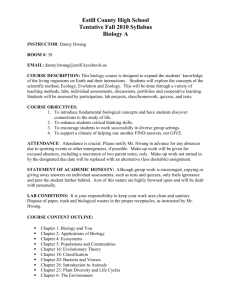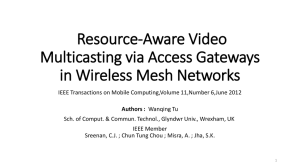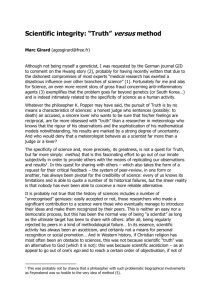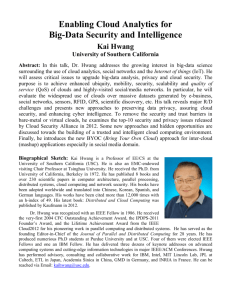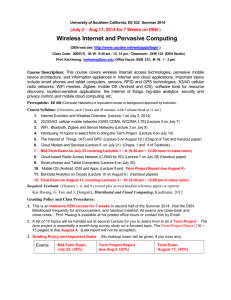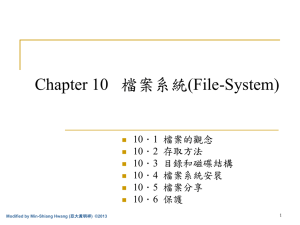A Two-Tier Test-based Approach to Improving Students' Computer
advertisement
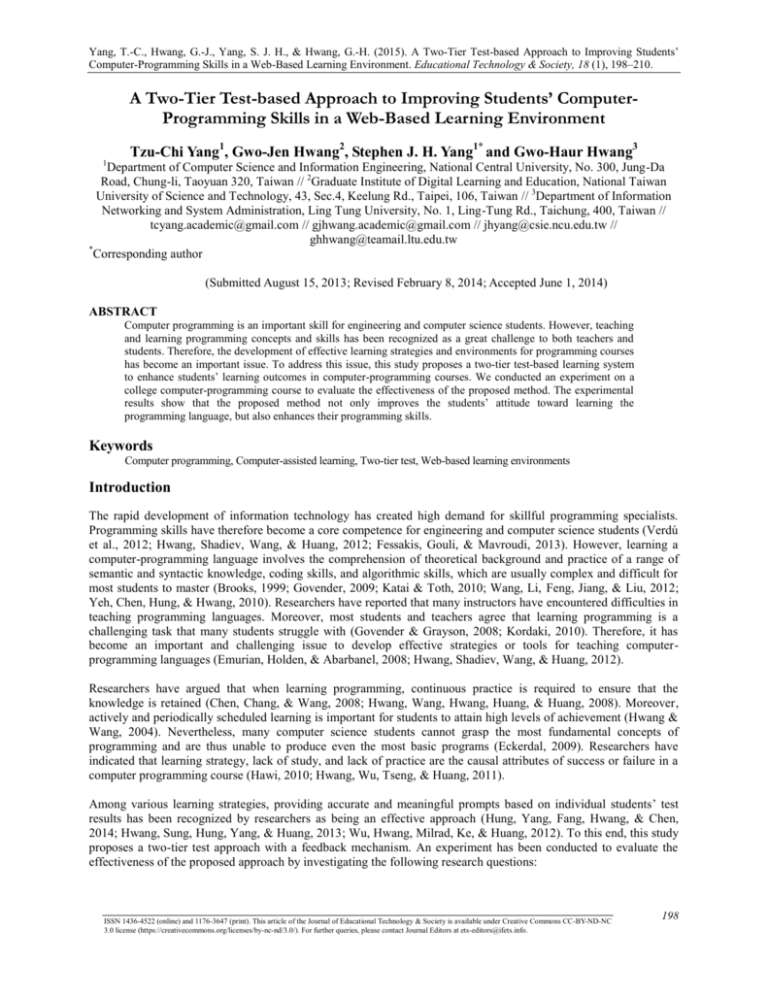
Yang, T.-C., Hwang, G.-J., Yang, S. J. H., & Hwang, G.-H. (2015). A Two-Tier Test-based Approach to Improving Students’
Computer-Programming Skills in a Web-Based Learning Environment. Educational Technology & Society, 18 (1), 198–210.
A Two-Tier Test-based Approach to Improving Students’ ComputerProgramming Skills in a Web-Based Learning Environment
Tzu-Chi Yang1, Gwo-Jen Hwang2, Stephen J. H. Yang1* and Gwo-Haur Hwang3
1
Department of Computer Science and Information Engineering, National Central University, No. 300, Jung-Da
Road, Chung-li, Taoyuan 320, Taiwan // 2Graduate Institute of Digital Learning and Education, National Taiwan
University of Science and Technology, 43, Sec.4, Keelung Rd., Taipei, 106, Taiwan // 3Department of Information
Networking and System Administration, Ling Tung University, No. 1, Ling-Tung Rd., Taichung, 400, Taiwan //
tcyang.academic@gmail.com // gjhwang.academic@gmail.com // jhyang@csie.ncu.edu.tw //
ghhwang@teamail.ltu.edu.tw
*
Corresponding author
(Submitted August 15, 2013; Revised February 8, 2014; Accepted June 1, 2014)
ABSTRACT
Computer programming is an important skill for engineering and computer science students. However, teaching
and learning programming concepts and skills has been recognized as a great challenge to both teachers and
students. Therefore, the development of effective learning strategies and environments for programming courses
has become an important issue. To address this issue, this study proposes a two-tier test-based learning system
to enhance students’ learning outcomes in computer-programming courses. We conducted an experiment on a
college computer-programming course to evaluate the effectiveness of the proposed method. The experimental
results show that the proposed method not only improves the students’ attitude toward learning the
programming language, but also enhances their programming skills.
Keywords
Computer programming, Computer-assisted learning, Two-tier test, Web-based learning environments
Introduction
The rapid development of information technology has created high demand for skillful programming specialists.
Programming skills have therefore become a core competence for engineering and computer science students (Verdú
et al., 2012; Hwang, Shadiev, Wang, & Huang, 2012; Fessakis, Gouli, & Mavroudi, 2013). However, learning a
computer-programming language involves the comprehension of theoretical background and practice of a range of
semantic and syntactic knowledge, coding skills, and algorithmic skills, which are usually complex and difficult for
most students to master (Brooks, 1999; Govender, 2009; Katai & Toth, 2010; Wang, Li, Feng, Jiang, & Liu, 2012;
Yeh, Chen, Hung, & Hwang, 2010). Researchers have reported that many instructors have encountered difficulties in
teaching programming languages. Moreover, most students and teachers agree that learning programming is a
challenging task that many students struggle with (Govender & Grayson, 2008; Kordaki, 2010). Therefore, it has
become an important and challenging issue to develop effective strategies or tools for teaching computerprogramming languages (Emurian, Holden, & Abarbanel, 2008; Hwang, Shadiev, Wang, & Huang, 2012).
Researchers have argued that when learning programming, continuous practice is required to ensure that the
knowledge is retained (Chen, Chang, & Wang, 2008; Hwang, Wang, Hwang, Huang, & Huang, 2008). Moreover,
actively and periodically scheduled learning is important for students to attain high levels of achievement (Hwang &
Wang, 2004). Nevertheless, many computer science students cannot grasp the most fundamental concepts of
programming and are thus unable to produce even the most basic programs (Eckerdal, 2009). Researchers have
indicated that learning strategy, lack of study, and lack of practice are the causal attributes of success or failure in a
computer programming course (Hawi, 2010; Hwang, Wu, Tseng, & Huang, 2011).
Among various learning strategies, providing accurate and meaningful prompts based on individual students’ test
results has been recognized by researchers as being an effective approach (Hung, Yang, Fang, Hwang, & Chen,
2014; Hwang, Sung, Hung, Yang, & Huang, 2013; Wu, Hwang, Milrad, Ke, & Huang, 2012). To this end, this study
proposes a two-tier test approach with a feedback mechanism. An experiment has been conducted to evaluate the
effectiveness of the proposed approach by investigating the following research questions:
ISSN 1436-4522 (online) and 1176-3647 (print). This article of the Journal of Educational Technology & Society is available under Creative Commons CC-BY-ND-NC
3.0 license (https://creativecommons.org/licenses/by-nc-nd/3.0/). For further queries, please contact Journal Editors at ets-editors@ifets.info.
198
Do the students who learn with the two-tier test-based learning approach show better programming knowledge
than those who learn with the conventional technology-enhanced learning approach?
Do the students who learn with the two-tier test-based learning approach show better programming skills than
those who learn with the conventional technology-enhanced learning approach?
Literature review
In the past decade, various teaching strategies and learning activities have been applied to computer-programming
courses for beginners (Govender & Grayson, 2008). For example, Machanick (2007) proposed the idea of
abstraction-first teaching by hiding details until students are ready for them. In addition, Emurian, Holden, and
Abarbanel (2008) employed a peer-tutoring approach, and Hwang, Shadiev, Wang, and Huang (2012) proposed a
web-based programming-assisted system to provide learning support for programming courses. In the meantime,
researchers have indicated that problem-based learning (PBL) could be a promising approach for programming
language learning (Kordaki, 2010; Pereira, Zebende, & More, 2010). For example, Gálvez, Guzmán, and Conejo
(2009) reported a problem-solving environment to diagnose students’ knowledge levels and to generate feedback and
hints to help students understand and overcome their misconceptions in learning programming languages.
According to the literature, providing effective support or guidance by identifying the knowledge levels and learning
difficulties of students in learning programming languages could be the key to the improvement in students’ learning
performance. Researchers have indicated the important role of assessment in identifying the learning status of
individual students in providing effective learning guidance (Hwang, 2003; Hwang, Panjaburee, Triampo, & Shih,
2013; Tseng, Chu, Hwang, & Tsai, 2008). Researchers have further argued that assessment could be used as a
learning strategy to improve students’ learning performance (Chu, Hwang, Tsai, & Tseng, 2010; Gálvez, Guzmán, &
Conejo, 2009). For example, Hauswirth and Adamoli (2013) proposed a pedagogical approach aligned with this
aspect that allows students to learn from their mistakes by answering a series of questions. On the other hand,
researchers have also indicated that assessing students’ programming knowledge and skills as well as identifying
their learning difficulties remains a challenging issue, implying the need to develop effective strategies or tools to
identify students’ status and provide learning support in programming language courses (Wang, Li, Feng, Jiang, &
Liu, 2012).
Among the various approaches to programming training, tests are a popular activity adopted by teachers for
examining students’ learning status and guiding them to learn (Hwang & Chang, 2011; Gálvez, Guzmán, & Conejo,
2009; Trotman & Handley, 2008; Wang, Li, Feng, & Lui, 2012). Researchers have reported the effectiveness of tests
in engaging students to learn and practice, by using multiple-choice items without detailed feedback (Roediger &
Karpicke, 2006). The effectiveness of this approach could be attributed to its positive effects on students’ learning
retention when engaging them in thinking and practising (Butler, Karpicke, & Roediger, 2007). Gálvez, Guzmán,
and Conejo (2009) further suggested that assessment itself can be used as a learning strategy.
Among the existing testing strategies, two-tier tests have been recognized as being an efficient and effective way of
investigating students’ prior knowledge or misconceptions, or alternative conceptions by many researchers,
especially in science education (Chu & Chang, 2014; Odom & Barrow, 1995; Tsai, 2001). A two-tier test consists of
a set of two-level multiple-choice questions. It was first introduced by Treagust (1988), mainly for diagnosing
students’ misconceptions or alternative conceptions in science (Tsai & Chou, 2002). The first tier assesses students’
descriptive or factual knowledge of a phenomenon. The second tier probes the students’ reasons for the choice they
made in the first tier. The aim of a two-tier test is to explore students’ in-depth explanations of the factual
knowledge, which allows teachers or researchers to not only understand students’ possible incorrect ideas, but also to
assess the reasoning or in-depth understanding behind these ideas (Chu, Hwang, Tsai, & Tseng, 2010).
In the past decade, researchers have employed the two-tier test approach as an assessment or learning guidance tool.
For example, Tsai and Chou (2002) developed a networked two-tier test system in which only one tier of a test item
is presented per screen. Such a system facilitates assessment of the existing knowledge of a larger sample of students
in a more efficient and relatively straightforward manner. Chou, Chan, and Wu (2007) employed a computerized
two-tier test method to assess students’ understanding and alternative conceptions of cyber copyright laws.
Researchers have argued that a computerized or web-based two-tier test is not only feasible and efficient, but also
provides an easy and familiar interface for students to answer the questions (Chou, Cha, & Wu, 2007). Moreover,
199
because a two-tier test is in a multiple-choice format, it is much simpler for researchers or educators to interpret
students’ responses.
Regarding the cognition levels of programming skills, Brooks (1999) indicated that programming skills can be
categorized into four levels (i.e., understanding of the task; finding methods; and coding, testing, and debugging the
program). Govender and Grayson (2008) proposed five levels of learning programming (i.e., meeting the
requirements, learning syntax, understanding and assimilating, problem solving, and programming in the large).
Furthermore, several researchers (Machanick, 2007; Hwang, Wang, Hwang, Huang, & Huang, 2008) have assessed
students’ programming skills based on Bloom’s taxonomy; that is, Knowledge, Comprehension, Application,
Analysis, Synthesis and Evaluation. Each level of cognitive development is an important dimension for evaluating
students’ learning state of programming.
In this study, we used a two-tier test as a strategy for guiding students to learn a programming language. We also
developed a web-based assessment and guidance system based on the proposed approach and conducted an
experiment to evaluate the learning performance of the students in terms of their programming knowledge
(Knowledge and Comprehension levels) and programming skills (Application levels) based on a knowledge test and
a skills test.
Two-tier test-based programming language learning system
In this study, we propose a two-tier test-based programming language learning system to support web-based learning
activities for computer-programming courses. We established a web-based learning environment with clientapplication-database server architecture. Moreover, we designed the user interface to adapt to the screen sizes of
different devices; that is, students are able to interact with the system using personal computers, notebooks, tablets,
or smartphones. Individual students can log into the system to review the teaching materials they have learned and to
take tests. When students answer a test item, the system provides immediate corresponding feedback, including the
correct answer, an explanation of the answer, and the supplementary material for the misconception if the student
fails to correctly answer the item.
Figure 1. System structure of the online two-tier test for programming learning
System framework and functions
We developed a web-based two-tier test system for programming learning, OT3PL, which stands for online two-tier
test for programming learning, to assist students in answering questions and justifying their answers with logical
arguments. A total of 147 first-tier test items were developed in this study for assessing students’ knowledge and
skills of object-oriented programming. Among them, 125 items related to the knowledge level, while 22 items
referred to the skills level. Moreover, 452 second-tier items were developed to further confirm the students’
200
knowledge and ability or to identify their learning difficulties. The proposed system consists of three subsystems: the
online test subsystem (OTS), the misconception diagnosis subsystem (MDS), and the learning content interactive
subsystem (LCIS). Figure 1 shows the overall framework of the OT3PL.
Online test subsystem
After learning a unit or concept, students are asked to finish at least one test before they continue on to the next unit.
The online test subsystem aims to generate two kinds of tests: (1) conventional multiple-choice questions selected
from the item bank; and (2) a two-tier test, in which every test item has four choices in the first tier, followed by
three or four reasons in the second tier for each choice. Table 1 shows an example of a two-tier test item for a
programming language. In a conventional multiple-choice item, only the three choices in the first tier (i.e., (A) bar =
blue, (B) bar = green, and (C) syntax error) are presented, while an additional nine choices are used to assess the
reasons for the students’ choice in a two-tier test item.
Table 1. Illustrative example of a two-tier test item
Given the following code:
1. public class Test{
2. public static void main(String[] args){
3. String foo = “blue”;
4. String bar = foo;
5. foo = “green”;
6. output.setText (“bar = “+bar);
7. }
8. }
What is the output?
First tier (the same in two kinds of test)
Second tier (asked in the two-tier test)
(A1) bar refers to string object “blue” via foo
(A)
bar = blue
(A2) “blue” assigned to bar immediately
(A3) bar assigned by a copy from foo
(B1) bar assigned to the same memory address as foo
(B2) bar and foo become the same object since the statement String
(B)
bar = green
bar = foo;
(B3) bar refers to foo
(C1) The String should be string (in lower-case)
(C)
Syntax error
(C2) Statement “bar =” + bar is incorrect,
(C3) In line 5, foo = “green”; causes an error
Figure 2. Comparison of a conventional online test and a two-tier test
201
To prevent students from memorizing the answers, the sequence of the choices and the programming language
variables in the test items are changed when generating test sheets. That is, no identical test sheets are generated
during the learning process. When making choices in the second tier, students are allowed to view the corresponding
first-tier item to identify the reason for making the choice. The scope of the tests is related to the weekly course
progress. Students are able to extend the test scope by including more concepts or units that they have learned.
Figure 2 shows the system interfaces of the conventional online test and the two-tier test. Figure 3 shows the test
results and feedback from the learning system.
Figure 3. Illustrative example of a test result and feedback
Misconception diagnosis subsystem
In the misconception diagnosis subsystem (MDS), the first-tier item is used to assess the students’ descriptive or
factual knowledge of programming problems. The second tier probes the students’ reasons for their choice made in
the first tier. Therefore, the choice made in the second-tier item not only confirms whether the students have fully
understood a concept, but also helps them to explore their misconceptions if incorrect reasons are selected.
Therefore, a decision-tree rule base is used in MDS for diagnosing students’ misconceptions or learning problems.
The two-tier test items were developed by two experienced teachers by referring to the past test data in the course.
Therefore, misconception identification in this study refers to finding the incorrect concepts, which leads students to
make mistakes in programming.
The decision tree for judging the students’ learning problems based on their answers is given in Figure 4. In this
example, it is possible for two string objects to have the same value but to be located in different areas of memory in
Java. The students may produce a logical error when developing software projects using variables that refer to other
variables whose values are changed in later steps if they do not completely understand how to work with objects. For
example, in a program, a variable <banana> = “green” and another variable <lemon> = <banana>, the value of
<lemon> is therefore “green.” Later, if <banana> is assigned as “yellow,” the students might think that the value of
<lemon> is “yellow,” too. In fact, the value of <lemon> remains the same (i.e., “green”). Figure 3 showed that the
choice of reason A2 implies that the student is not familiar with the process of string objects, especially value
assignment, while if the student takes reason A3 into account, he/she may be confused about how the value of a
string object is located in memory.
202
Figure 4. Decision tree for justifying the learning status of students
To develop the items for the two-tier test, eight graduate students with more than two years’ programming
experience were employed to construct the test items. For example, Table 2 shows four items revised by the teacher
in order to identify whether the student completely understands the operator, flow control, and the scope of the
variables. The four items in this example are very similar and seem easy to answer. However, even if students are
familiar with the use of increasing operators, they will fail to construct flow control statements properly if they do
not precisely understand the prefix and postfix of an operator.
Table 2. Sample test item
What is the value of i after executing the following code?
int i; for(i=1;i<5;i=i+1);
What is the value of i after executing the following code?
int i=4;
for(i=1;i<5;i+=1);
What is the value of i after executing the following code?
int i;
for(i=1;i<5;i=++i);
What is the value of i after executing the following code?
int i;
for(i=1;i<5;i=i++);
Result
i=5
i=5
i=4
unexpected looping
Learning content interactive subsystem
The learning content interactive subsystem (LCIS) presents up-to-date learning contents, including learning material
extracted from the textbook and demonstrated programming code provided by the teacher. Students are able to
review the correlated contents at any time, such as slides used in the class and the examples given by the teacher.
Based on the students’ misconceptions or learning status reported by MDS, LCIS provides relevant supplementary
materials to help the students overcome their misconceptions. When students take a test, LCIS presents a list of
highlights and provides students with the recommended learning materials. Figure 5 shows an illustrative example of
providing personalized learning content to individual students based on test results.
203
The list of subject units for the student to correct his/her
misconceptions.
The student is allowed to select the
subject units for further studying.
The list of subject units that
the student might not be
familiar with.
The learning content related
to the use of “array.”
The learning content related
to the parameters and return
values of a subprogram.
Figure 5. Example of providing personalized comments and learning materials
Experiment design
To evaluate the efficacy of the proposed approach, we conducted an experiment to compare the learning
achievements and attitudes of the students who were learning the programming language using the proposed
approach. We conducted the experiment on the learning activities of the “Developing Android applications using
Java” course of a college in central Taiwan. Details of the experiment are stated below.
Participants
Eighty-eight college students participated in the online programming learning activity. The average age of the
students was 20. They were randomly divided into an experimental group and a control group. Eventually, 79
students completed all of the activities, with 40 in the experimental group and 39 in the control group. All of the
students were taught by the same teacher.
Treatment
The aim of the course was to train students to develop application programs for mobile devices. The target
programming language was Java. The learning objectives included understanding the Java syntax, learning
debugging skills, and programming with Java statements to complete specified problems.
204
Figure 6 presents the experiment design of this study. Both groups of students first received instruction on the basic
knowledge of the programming language (Java), then took a pre-test and completed a questionnaire to analyze their
knowledge of and attitudes towards the programming language before interacting with the proposed system.
In the first stage of the activity, both groups of students received face-to-face classroom instruction. The teacher
provided instruction on the basic syntax and executive environment of Java. The students were then asked to
complete a segment of code and perform an exercise based on what they had learned in the classroom.
In the second stage, both groups of students were asked to take a test on the system after each class. In general, they
completed at least five exercises and one test each week. In this stage, the students in the experimental group learned
with OT3PL. On the other hand, the students in the control group learned with the conventional technologyenhanced learning approach; that is, they were allowed to browse the same learning materials and do the same
exercises, but they receives conventional tests and feedback in the web-based learning system.
The learning activity was conducted for four weeks for both groups. After the learning activity, both groups of
students took a post-test. They were then asked to fill in the same questionnaire to measure if their attitudes towards
programming learning had changed.
Figure 6. Experiment procedure
Measuring tools
Both the pre-test and the post-test were developed by consulting two teachers who had taught the programming language course
for more than five years. The pre-test consisted of 33 multiple-choice items, with a total score of 100. The pre-test was designed
to evaluate the students’ basic knowledge concerning computer science and programming before the learning activity. The posttest, a detailed achievement test on the Java language, consisted of a programming knowledge test and a programming skills test.
The programming knowledge test consisted of 30 multiple-choice items for conceptions, data structure, and coding of Java. The
programming skills test consisted of five programming problems. The perfect scores for the two dimensions were 30 and 70,
respectively.
The questionnaire for “attitudes toward the programming language course” consisted of seven items. A six-point
Likert scheme was used to rate the questionnaire items, where 6 meant strong agreement or positive feedback and 1
represented high disagreement or negative feedback. The Cronbach’s alpha value of the questionnaire was 0.94.
205
Experimental results
The students’ learning performance was evaluated based on two dimensions, that is, the programming knowledge
and programming skills. The former was concerned with the students’ knowledge of programming, such as variables,
syntax, and programming concepts. Namely, the programming knowledge dimension focused on the ability of
remembering and comprehension of the Java language, and was evaluated by a set of multiple choice items as shown
in Table 3.
On the other hand, programming skills refer to the ability of completing software programs based on the specified
purposes or function. In other words, to complete a programming task, students require not only programming
knowledge and the syntax of the target programming language, but also the ability of identifying problems,
organizing codes, and solving problems (Hauswirth & Adamoli, 2013). In this study, the students’ programming
skills were evaluated based on the correctness of the programs they developed. For example, they were asked to
complete several Android application programs, such as “Please design project T3, such that the screen presents the
user’s name in blue when the user touches the screen, but presents the user’s name in red when the user touches the
screen for more than two seconds” and “Given the following four pictures, please design project T4, such that users
can switch pictures by sliding their finger.” Based on Bloom’s taxonomy, programming knowledge involves
recognizing and remembering the usage of Java statements, which develops the Knowledge level and the
Comprehension level. Moreover, the programming skills required include solving problems and organizing code
statements, relating mainly to the Application level (Anderson & Krathwohl, 2001; Bloom, 1994).
Table 3. Examples of multiple choice items for evaluating programming knowledge
Item 10. What is the result of calling the following codes?
int i=1,j=10;
do{
A. i = 6 and j = 5
if (i>j) {
B. i = 5 and j = 5
break;
C. i = 6 and j = 4
}
D. i = 5 and j = 6
j--;
}while(++i<5);
Output.setText(“i=“+i+”and j=“+j);
Item 21. What is the result of calling the following codes?
String s = “hello” +9 +1 ;
Output.setText (s) ;
A. Hello91
B. Hello10
C. Compiling error
D. Throws an exception
Item28. public class MethodOver {
public void setVar(int a , int b , float c){ }
}
Which of the following is an overloading method of serVar?
A. private void setVar (int a , float c , int b ) {}
B. protected void setVar (int a , int b , float c ) {}
C. public int setVar (int a , int b , float c ) {return a;}
D. protected void setVar (int a , int b , float c )
{ return c;}
Before participating in the learning activity, the students took a pre-test to evaluate their basic knowledge of
computer science and programming languages. The means and standard deviations of the pre-test scores were 67.80
and 13.03 for the experimental group, and 66.87 and 11.49 for the control group. A t-test performed on the pre-test
scores showed no significant difference between the pre-test results of the two groups, with t = 0.335 and p > .05;
that is, the two groups of students had equivalent knowledge of the computer language prior to the learning activity.
After conducting the two-tier test learning activity, the two groups’ programming knowledge test and programming
skills test scores were compared. It was found that the students in the experimental group had significantly better
programming skills than the control group, while no significant difference was found between their programming
knowledge test scores, as shown in Table 4. According to the aforementioned, the programming knowledge
represents the abilities of remembering and comprehending the Java language, while programming skills refers to the
ability of organizing programming codes and solving problems. The two-tier test system aimed to help students
identify their misconceptions of programming, which could be related to the syntax and semantics of the
programming language, or the ability of organizing the programming codes for dealing with a practical problem.
206
From the experimental results, we found that the two-tier test system benefited the students more in terms of
improving their ability of solving problems by organizing the codes in correct ways. In addition, we observed during
the learning activity that one third of the students in the experimental group completed all of the tasks in the
programming skills test, while most of the students in the control group completed only three tasks.
It should be noted that, in this study, the two-tier test approach was a learning guidance method rather than a test
method. The purpose of using the approach was to help the students identify their learning difficulties or problems
such that they were able to efficiently cope with the problems via reading supplementary materials or discussing with
peers. The effectiveness of such learning guidance or prompts has been reported by several previous studies in
science or mathematics courses (Chu et al., 2010; Panjaburee et al., 2013). The interview results from 11 participants
provide further evidence for the effectiveness of the two-tier test approach in helping them comprehend the
programming knowledge and improve their programming skills. For example, several students have argued that the
learning system improved their programming knowledge and skills.
S01: “There are many statements that I did not really understand, because I do not usually use them. However, I
have understood the statements since taking the test and following the guidance provided by the learning system.”
S02: “I always study very hard. However, I did not find my weakness in programming and the misconceptions of the
programming language until I learned with this system and did the practice.”
S03: “The system refined my knowledge and improved my ability in the programming areas that I did not learn
well.”
S08: “It is not easy to learn a programming language by only reading the materials in books and practising without
immediate feedback. It is important to do such practice. The test and feedback process is really helpful to me in
improving my programming ability.”
Other students also shared similar thoughts that the learning approach not only helped them identify their learning
problems, but also improved their programming ability by organizing what they had learned to solve the problems
and complete the projects. From the feedback of the students and the experimental results, it is concluded that the
two-tier test approach benefited the students by correcting their misconceptions of programming and guiding them to
effectively improve their programming knowledge and skills during the learning process.
Such a finding implies that the OT3PL approach can improve the students’ programming skills by enhancing their
logical reasoning and by helping them make connections between the programming language (e.g., syntax and
types), programming concepts (e.g., variables, data structure, and control flow) and programming procedures (e.g.,
solving programming problems).
Table 4. The t-test results of the programming knowledge and programming skills tests for the two groups
Group
N Mean
SD
t
Experimental group
40 20.49
2.95
−1.442
Programming knowledge test
Control group
39 21.48
3.12
Experimental group
40 55.05
21.00
2.546*
Programming skills test
Control group
39 44.49
15.36
*
p < .05.
Table 5 shows the t-test result of the students’ attitudes toward learning the programming language before and after
the learning activity. We found that the learning attitude of the students in the experimental group significantly
improved after the learning activity, while the change in the control group students’ attitudes was not significant.
This finding conforms to previous studies concerning technology-enhanced learning that effective learning guidance
strategies or mechanisms are helpful to students in terms of improving their learning attitudes as well as their
learning achievements (Chu, Hwang, Tsai & Tseng, 2010; Hwang & Chang, 2011).
Table 5. The paired t-test result of the students’ attitudes toward programming learning before and after the learning activity
Experimental group (N = 40)
Control group (N = 39)
Mean (SD)
t
p
Mean (SD)
t
p
Attitudes toward
Before
4.68 (1.26)
4.90
(1.29)
−3.36**
0.003
0.54
0.59
programming learning
After
5.33 (1.06)
4.82 (1.11)
**
p < .01.
207
Conclusions
In this paper, we proposed a two-tier test approach for programming learning. Moreover, an online two-tier test
system for programming learning with misconception diagnostics and a feedback mechanism, OT3PL, has been
implemented based on the proposed approach. OT3PL assists students in assessing their misconceptions of
knowledge of programming and in improving their programming skills by judging numbers of statements of code
and verifying their reasons. We conducted an experiment on a course on developing Android applications to evaluate
the effectiveness of the proposed approach by comparing the learning performance of the students who learned with
OT3PL and those who learned with the conventional technology-enhanced learning approach. From the experimental
results, we found that, with the help of OT3PL, the experimental group students showed significantly better
programming skills than those in the control group.
The finding implies that the two-tier test approach can benefit the students in terms of improving their procedure
knowledge rather than their declarative knowledge. Procedural knowledge is the type of knowledge related to how to
perform a task, solve problems, or complete a project (Chu, Hwang, Huang, & Wu, 2008; Lewicki, Hill, & Bizot,
1988). In this study, the programming problems in the programming skills test engaged the students in organizing the
aims and functions of the problem and applying various programming concepts, syntax, and flow control skills to the
development of the program; therefore, the test is relevant to procedural knowledge as well as to the application level
of cognition in Bloom’s taxonomy. This finding is reasonable since the two-tier test approach can help students find
the learning problems through the interactive questioning and feedback-providing mechanism. On the other hand, the
programming knowledge test is related to declarative knowledge, which represents the description of facts or
information and is related to the Knowledge and Comprehension levels of cognition. It is also reasonable to find that
the two groups of students did not show significant difference in terms of programming knowledge since both
approaches (two-tier test-based learning and conventional online test learning) provided the same learning materials
to the students to memorize and comprehend.
Although OT3PL benefited the students in this application, there are some limitations to be noted. First,
generalization of the findings may be limited to populations of a similar nature, but may not be very applicable for
other learner groups with different educational settings or cultural backgrounds. Secondly, the number of students
participating is rather small. Third, to provide feedback and judgment, the teachers need to spend time reviewing and
refining the test items for evaluation purposes, and the digital learning materials for providing learning supports.
Further research is therefore needed in this area, particularly concerning students of diverse academic degrees and
knowledge background. Moreover, it is worth extending this study to the Analysis and Synthesis levels by engaging
students in analyzing and improving some existing programs, for example, by reorganizing and reducing code
statements for improving the efficiency of the programs. On the other hand, it is also interesting to provide other
learning supports, such as collaboration and annotation mechanisms to the learners (Sung & Hwang, 2013; Yang,
Yu, & Sun, 2013). In the near future, we will apply this approach to other programming courses to investigate in
depth how students look at the system and how they think the system helps them in our future work. Moreover, we
plan to investigate the patterns of online behaviors and identify which patterns of behavior possibly result in different
learning performance in such a learning activity.
Acknowledgements
This study was supported in part by the National Science Council of the Republic of China under contract numbers
NSC 101-2511-S-008-011-MY3, and NSC 101-2511-S-011-005-MY3.
References
Anderson, L. W., & Krathwohl, D. R. (Eds.) (2001). A taxonomy for learning, teaching, and assessing: A revision of Bloom’s
taxonomy of educational objectives. New York, NY: Addison Wesley Longman.
Bloom, B. S. (1994). Reflections on development and use of the taxonomy. In L. W. Anderson & L. A. Sosniak (Eds.), Bloom’s
taxonomy: A forty-year retrospective (pp. 1–8). Chicago, IL: The National Society for the Study of Education.
208
Brooks, R. (1999). Towards a theory of the cognitive processes in computer programming. International Journal of Human
Computer Studies, 51, 197–211.
Butler, A. C., Karpicke, J. D., & Roediger, H. L. (2007). The effect of type and timing of feedback on learning from multiplechoice tests. Journal of Experimental Psychology: Applied, 13(4), 273–281.
Chen, G. D., Chang, C. K., & Wang, C. Y. (2008). Using adaptive e-news to improve undergraduate programming courses with
hybrid format. Computers & Education, 51, 239–251.
Chou, C., Chan, P. S., & Wu, H. C. (2007). Using a two-tier test to assess students’ understanding and alternative conceptions of
cyber copyright laws. British Journal of Educational Technology, 38(6), 1072–1084.
Chu, H. C., & Chang S. C. (2014). Developing an educational computer game for migratory bird identification based on a two-tier
test approach. Educational Technology Research & Development, 62(2), 147–161.
Chu, H. C., Hwang, G. J., Huang, S. X., & Wu, T. T. (2008). A knowledge engineering approach to developing e-libraries for
mobile learning. The Electronic Library, 26(3), 303–317.
Chu, H. C., Hwang, G. J., Tsai, C. C., & Tseng, J. C. R. (2010). A two-tier test approach to developing location-aware mobile
learning systems for natural science courses. Computers & Education, 55, 1618–1627.
Eckerdal, A. (2009). Novice programming students’ learning of concepts and practise (Doctoral dissertation), Retrieved from
http://uu.diva-portal.org/smash/record.jsf?pid=diva2:173221
Emurian, H. H., Holden, H. K., & Abarbanel, R. A. (2008). Managing programmed instruction and collaborative peer tutoring in
the classroom: Applications in teaching JavaTM. Computers in Human Behavior, 24, 576–614.
Fessakis, G., Gouli, E., & Mavroudi, E. (2013). Problem solving by 5–6 years old kindergarten children in a computer
programming environment: A case study. Computers & Education, 63, 87–97.
Gálvez, J., Guzmán, E., & Conejo, R. (2009). A blended e-learning experience in a course of object oriented programming
fundamentals. Knowledge-Based Systems, 22, 279–28.
Govender, I., & Grayson, D. J. (2008). Pre-service and in-service teachers’ experiences of learning to program in an objectoriented language. Computers & Education, 51, 874–885.
Govender, I. (2009). The learning context: Influence on learning to program. Computers & Education, 53, 1218–1230.
Hauswirth, M, & Adamoli, A. (2013). Teaching Java programming with the Informa clicker system. Science of Computer
Programming, 78, 499–520.
Hawi, H. (2010). Causal attributions of success and failure made by undergraduate students in an introductory-level computer
programming course. Computers & Education, 54, 1127–1136.
Hung, I. C., Yang, X. J., Fang, W. C., Hwang, G. J., & Chen, N. S. (2014). A context-aware video prompt approach to improving
in-field reflection levels of students. Computers & Education, 70(1), 80–91.
Hwang, G. J. (2003). A concept map model for developing intelligent tutoring systems. Computers & Education, 40(3), 217–235.
Hwang, G. J., & Chang, H. F. (2011). A formative assessment-based mobile learning approach to improving the learning attitudes
and achievements of students. Computers & Education, 56(4), 1023–1031.
Hwang, G. J., Panjaburee, P., Triampo, W., & Shih, B. Y. (2013). A group decision approach to developing concept-effect models
for diagnosing student learning problems in mathematics. British Journal of Educational Technology, 44(3), 453–468.
Hwang, G. J., Sung, H. Y., Hung, C. M., Yang, L. H., & Huang, I. (2013). A knowledge engineering approach to developing
educational computer games for improving students’ differentiating knowledge. British Journal of Educational Technology,
44(2), 183–196.
Hwang, G. J., Wu, C. H., Tseng, Judy C. R., & Huang, I. W. (2011). Development of a ubiquitous learning platform based on a
real-time help-seeking mechanism. British Journal of Educational Technology, 42(6), 992–1002.
Hwang, W. Y., & Wang, C. Y. (2004). A study on learning time pattern in asynchronous learning environments. Journal of
Computer Assisted Learning, 20 (4), 292–304.
Hwang, W. Y., Shadiev, S., Wang, C. Y., & Huang, Z. H. (2012). A pilot study of cooperative programming learning behavior
and its relationship with students’ learning performance. Computers & Education, 58, 1267–1281.
209
Hwang, W.Y., Wang, C. Y., Hwang, G. J., Huang, Y. M., & Huang S. (2008). A web-based programming learning environment
to support cognitive development. Interacting with Computers, 20, 524–534.
Katai, T, & Toth, L. (2010). Technologically and artistically enhanced multi-sensory computer-programming education. Teaching
and Teacher Education, 26, 244–251.
Kordaki, M. (2010). A drawing and multi-representational computer environment for beginner learning of programming using C:
Design and pilot formative evaluation. Computers & Education, 54, 69–87.
Lewicki, P., Hill, T, & Bizot, E. (1988). Acquisition of procedural knowledge about a pattern of stimuli that cannot be articulated.
Cognitive Psychology, 20(1), 24–37.
Machanick, M. (2007). Teaching Java backwards. Computers & Education, 48, 396–408.
Odom, A. L., & Barrow, L. H. (1995). The development and application of a two-tiered diagnostic test measuring college biology
students’ understanding of diffusion and osmosis following a course of instruction. Journal of Research in Science Teaching,
32(1), 45–61.
Panjaburee, P., Triampo, W., Hwang, G. J., Chuedoung, M., & Triampo, D. (2013). Development of a diagnostic and remedial
learning system based on an enhanced concept effect model. Innovations in Education and Teaching International, 50(1), 72–84.
Pereira, H. B. B., Zebende, G. F., & More, M. A. (2010). Learning computer programming: Implementing a fractal in a Turing
machine. Computers & Education, 55, 767–776.
Roediger, H. L., & Karpicke, J. D. (2006). Test-enhanced learning: Taking memory tests improves long-term retention.
Psychological Science, 17(3), 249–255.
Sung, H. Y., & Hwang, G. J. (2013). A collaborative game-based learning approach to improving students’ learning performance
in science courses. Computers & Education, 63(1), 43–51.
Treagust, D. F. (1988). Development and use of diagnostic tests to evaluate students’ misconceptions in science. International
Journal of Science Education, 10(2), 159–169.
Trotman, A., & Handley, C. (2008). Programming contest strategy. Computers & Education, 50(3), 821–837.
Tsai, C. C. (2001). The interpretation construction design model for teaching science and its applications to Internet-based
instruction in Taiwan. International Journal of Educational Development, 21, 401–415.
Tsai, C. C., & Chou, C. (2002). Diagnosing students’ alternative conceptions in science. Journal of Computer Assisted Learning,
18, 157–165.
Tseng, Judy C. R., Chu, H. C., Hwang, G. J., & Tsai, C. C. (2008). Development of an adaptive learning system with two sources
of personalization information. Computers & Education, 51(2), 776–786.
Verdú, E., Regueras. L. M., Verdú, M. J., Leal, P. J., Castro, J. P., & Queirós, R. (2012). A distributed system for learning
programming online. Computers & Education, 58, 1–10.
Wang, Y., Li, H., Feng, Y., Jiang, Y., & Liu, Y. (2012). Assessment of programming language learning based on peer code
review model: Implementation and experience report. Computers & Education, 59, 412–422.
Wu, P. H., Hwang, G. J., Milrad, M., Ke, H. R., & Huang, Y. M. (2012). An innovative concept map approach for improving
students’ learning performance with an instant feedback mechanism. British Journal of Educational Technology, 43(2), 217–232.
Yang, X. M., Yu, S. Q., & Sun, Z. (2013). The effect of collaborative annotation on Chinese reading level in primary school of
China. British Journal of Educational Technology, 44(1), 95–111.
Yeh, Y. F., Chen, M. C., Hung, P. H., & Hwang, G. J. (2010). Optimal self-explanation prompt design in dynamic multirepresentational learning environments. Computers & Education, 54(4), 1089–1100.
210
